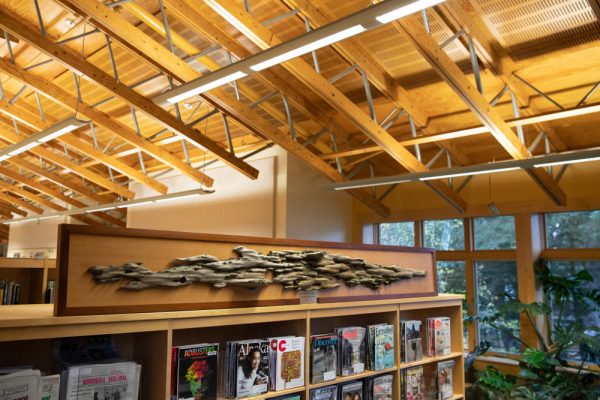
A real piece of local history is now on display at the Petersburg Public Library. It’s part of a wooden barge that wrecked in a notoriously bad part of the Wrangell Narrows south of Petersburg at the turn of the last century. That area was later named after that shipwreck.
The wooden plank on display is from the 983-ton barge Colorado. According to the book “Alaska Shipwrecks” by Warren Good, it left Juneau April 20th, 1901 bound for Tacoma, Washington. The barge was under tow by the British steam tug Pilot when it hit a reef in the Wrangell Narrows opposite Anchor Point, about 14 miles south of Petersburg at 5:15 p.m. on Monday April 22nd.
The barge, valued at eight thousand dollars was a total loss, as well as a portion of its cargo, listed as sulphurite concentrates.
The hull piece was recovered by Andy Mathisen in the 1970s. He passed away in 2008, but before that gave the piece to another local resident Doug Corl, who built the mount and donated it to the Clausen Museum.
Museum director Cindi Lagoudakis said the piece really adds to the maritime history of the Petersburg area.
“From looking back at some of the records, it looks like some of the surveys that had been done of the narrows actually were pretty poor, not too correct for that era,” Lagoudakis said. “The captain of that ship when the barge hit the reef claimed that the buoy was misplaced. And so whether or not that’s true, that vessel went down.”
There’s more space for displaying the piece at the public library, so it’s on long-term loan there. Corl, who donated the piece, thinks the wood from the barge is oak and all the fittings are copper, with green coloring marking the reddish boards, which also appear eaten away by time and tide.
“Alaska Shipwrecks” says the barge was built in Boston, Massachusetts in 1864 and it was registered to a company in San Francisco. It had a crew of seven but none were lost in the grounding. It had no insurance. It carried over a thousand tons of the concentrates with a total value of 40-thousand dollars.
Colorado Reef and a nearby creek were both named after the wreck, by no means the only vessel to run into difficulty there. Archived newspaper accounts detail some work to dynamite that reef and improve that channel during the spring of 1928 and note it as a well-known problem spot. Other newspaper notices warn mariners of strong tides and ice bergs that sometimes moved buoys in that area. Other dredging work happened there in 1963. The piece of hull is on display above the periodicals near the fireplace at the library.
Joe Viechnicki is a reporter at KFSK in Petersburg.




